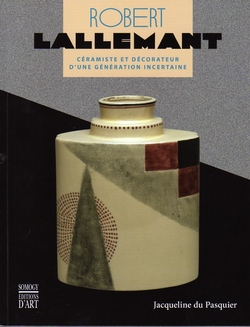
This is the first extended study of the work of the revolutionary French Art Deco ceramicist Robert Lallemant (1902-1954), who flourished in Paris between 1925 and 1933 before mostly abandoning ceramics for furniture design, interior decorating, architecture, travel and photography. Lallemant has been somewhat overlooked by French art history, partly because he was a successful artist-businessman, and partly also because of the brevity of his career, the originality of his designs, and his friendship with Maréchal Philippe Pétain, ‘Head of State’ of the collaborationist Vichy government during the Second World War. Du Pasquier, who has published numerous books on French art ceramics and glassware, particularly those of the Bordeaux region, devotes almost a third of the book to Lallemant’s two years – 1943-44 – as “Special adviser to the civil office of the Head of the State” or “Artistic Advisor to the Maréchal” – ostensibly to show the non-political nature of his devotion to the aging general.
Lallemant’s sister-in-law, Aline Montcocol, was the wife of Pétain’s close friend and personal physician, Bernard Ménétrel, who became his chief of staff during the Vichy period. After the war Pétain was convicted of treason, sentenced to death, and died in prison in 1951, age 95, having had his sentence commuted. Ménétrel was also tried but released in disgrace with the case against him declared unproven, and died shortly after in an automobile crash. His widow subsequently became president of a controversial ultra-nationalist association ("L'Association pour défendre la mémoire du maréchal Pétain" or "ADMP") founded to rehabilitate Pétain’s memory. Lallemant himself, who had joined the French navy when war was declared, had moved his wife and children to the relative security of
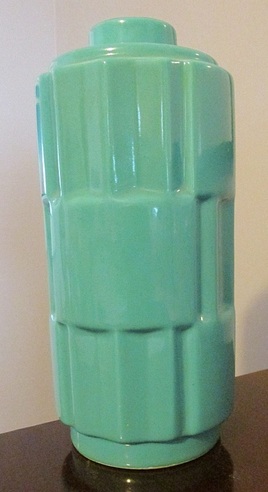 Robert Lallemant vase, ca. 1925, h. 25 cm.
Robert Lallemant vase, ca. 1925, h. 25 cm. Du Pasquier offers a largely romantic portrait of Lallemant as a brilliant but unanalytical, non-reflective artist-entrepreneur who inexplicably intuited – at age 22 – the extreme aesthetics that his period was calling for. Obliged to write almost entirely on the basis of interviews with his widow, a family archive that appears to contain mainly designs and sketches, and diaries in which the artist recorded mostly mundane matters such as meetings and travels, she is left to explore his possible motivations and influences through speculation or rhetorical questions, or through the interpretations of the few 1925-33 critics who commented on him.
On his remarkable vases, bookends, lamp bases, cigarette cases and ceramic sculptures she follows those critics and the organizers of the 1984 exhibition “Robert Lallemant ou la céramique mécanisée” closely. “[S]es formes sont resolument nouvelles,” she writes, “eventuellment liées a l’esthétique de la machine” (27). They are geometric, with angles and straight lines, and strictly parallel planes, which suggest the influence of cubism, as well as reflecting the functionality of contemporary technical devices. Unlike Art Nouveau and earlier ceramic styles, they are not intended to be beautiful, merely mathematical. She also notes that he is among the first French ceramicists to adopt machine-age production methods – his productions are not unique objects, turned on a wheel, but series productions of the same form, “interchangeables,” produced in moulds. These methods reduced the price – and for a while the fetish-value – of the individual work, and democratized access to what had been high-end art work. Older ceramicists, such as Raoul Lachenal with whom Lallemant had apprenticed and who had been one of the pioneers of series creation, would begin marking some of their works “pieces unique” in order to distinguish them from the new ‘mass production.’
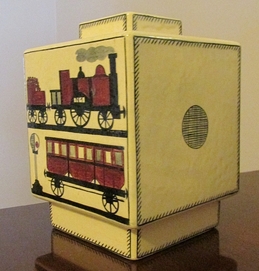 Lallemant vase, ca 1925, h. 17.5 cm
Lallemant vase, ca 1925, h. 17.5 cm Cubism, however, had been evident in European painting since before 1910, and the idea that art did not need to be “beautiful” had been present at least there and in German Expressionism as well the work in the work of such different painters as Wyndham Lewis and Egon Schiele and in the "Imagist Manifesto" of Ezra Pound. Perhaps because more dependent than painters on substantial numbers of bourgeois buyers, ceramics had mostly resisted this trend, although one can see a considerable movement toward abstraction before and during the First World War in the Amphora potteries of Turn-Teplitz and the Bavarian work of Max Laeuger. Overall, there was much modernist art in Europe in the early 1920s that could have come to the attention of the youthful Lallemant -- even in ceramics. One could also argue that what was innovative about him was as much his insight that cubist forms and designs were now marketable to the bourgeoisie as it was his novel production of these in a serial ceramics medium. In Pierre Bourdieu’s terms, he was succeeding briefly but brilliantly in selling the largely unconsecrated symbolic goods of the recent past and present as commercial goods of the present and future.
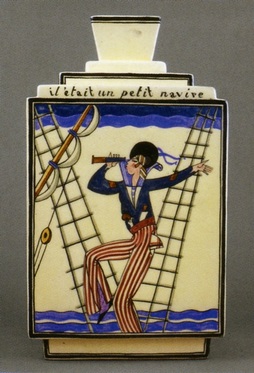 Lallemant vase, form 2095, h 17.5 cm. Du Pasquier 28.
Lallemant vase, form 2095, h 17.5 cm. Du Pasquier 28. 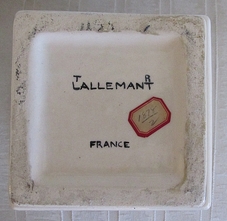 The T R Lallemant mark.
The T R Lallemant mark. 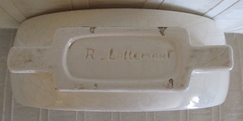 An engraved R. Lallemant signature.
An engraved R. Lallemant signature. 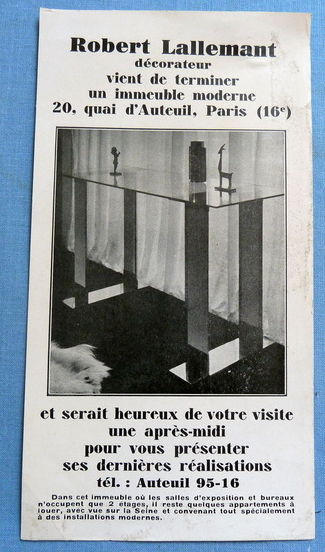 Leaflet (ca 1933) announcing Lallemant's closing of his Paris showroom
Leaflet (ca 1933) announcing Lallemant's closing of his Paris showroom FD
 RSS Feed
RSS Feed